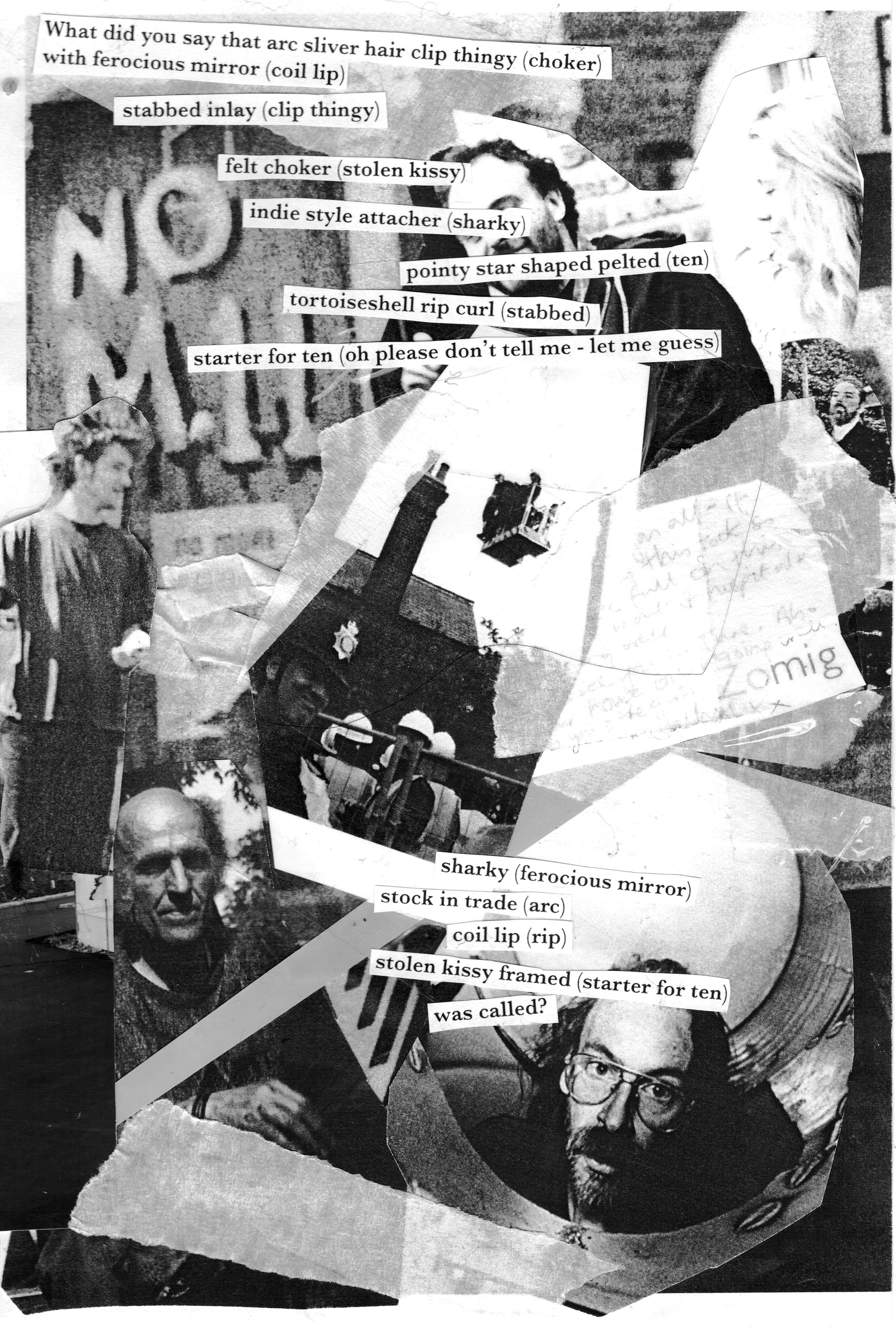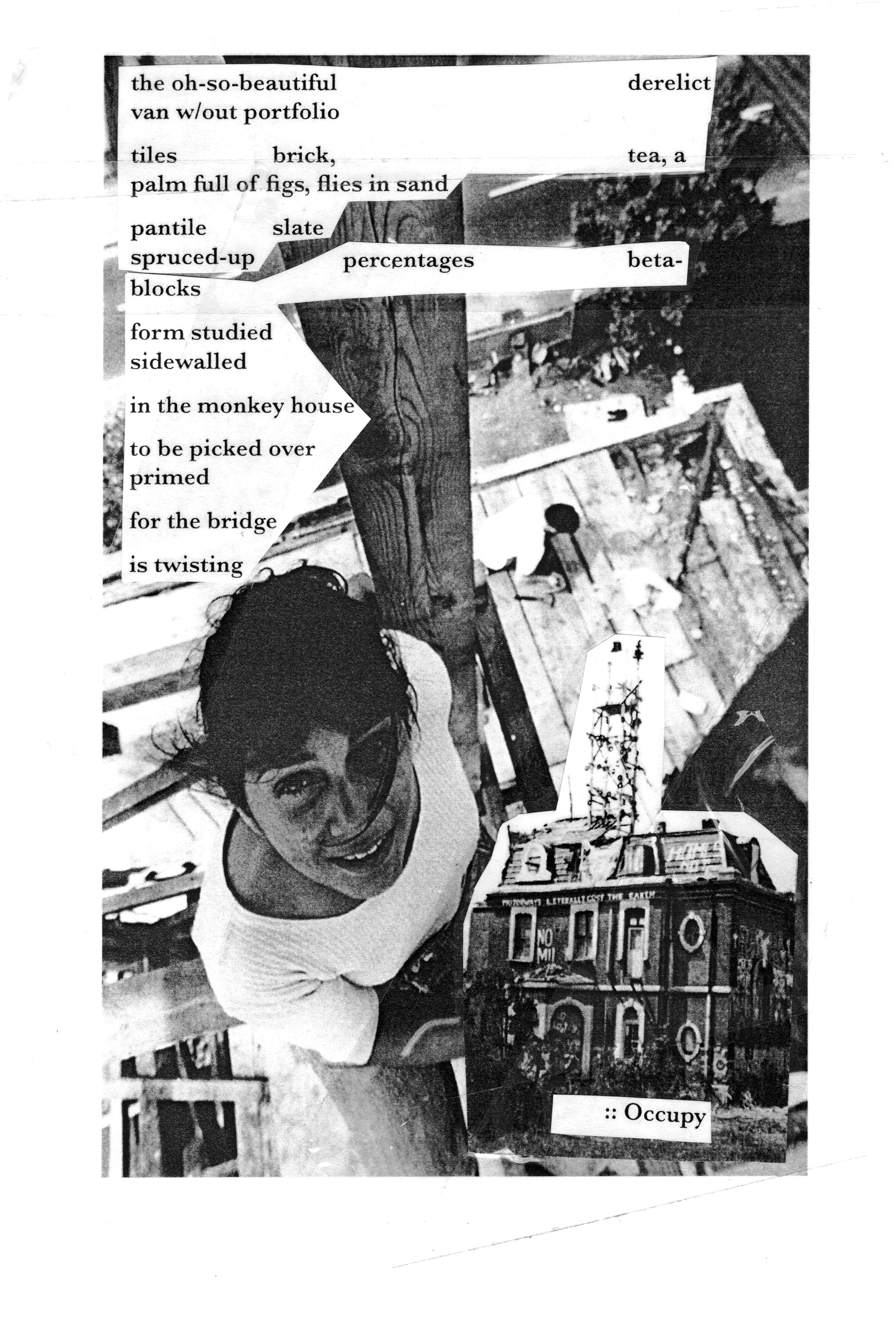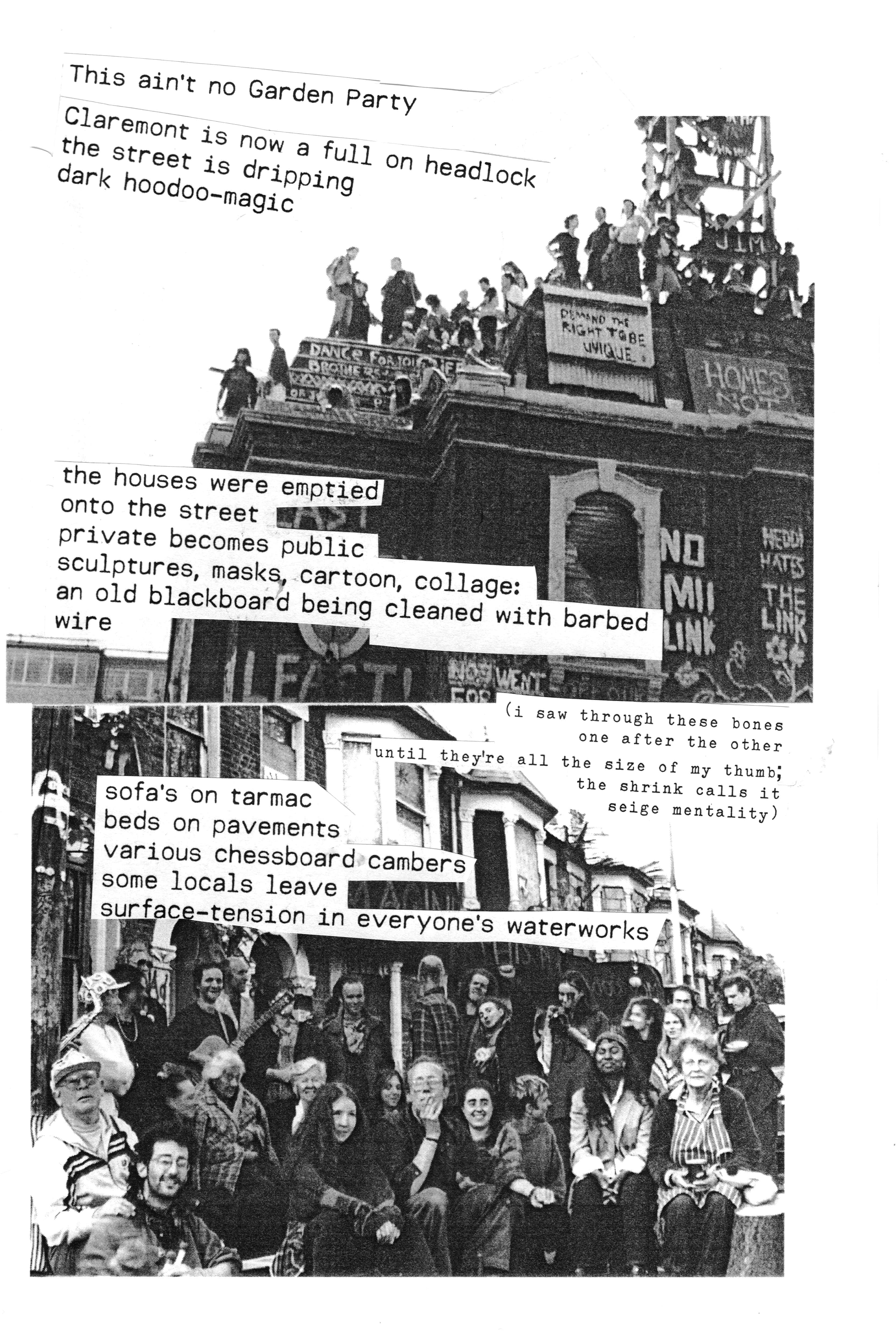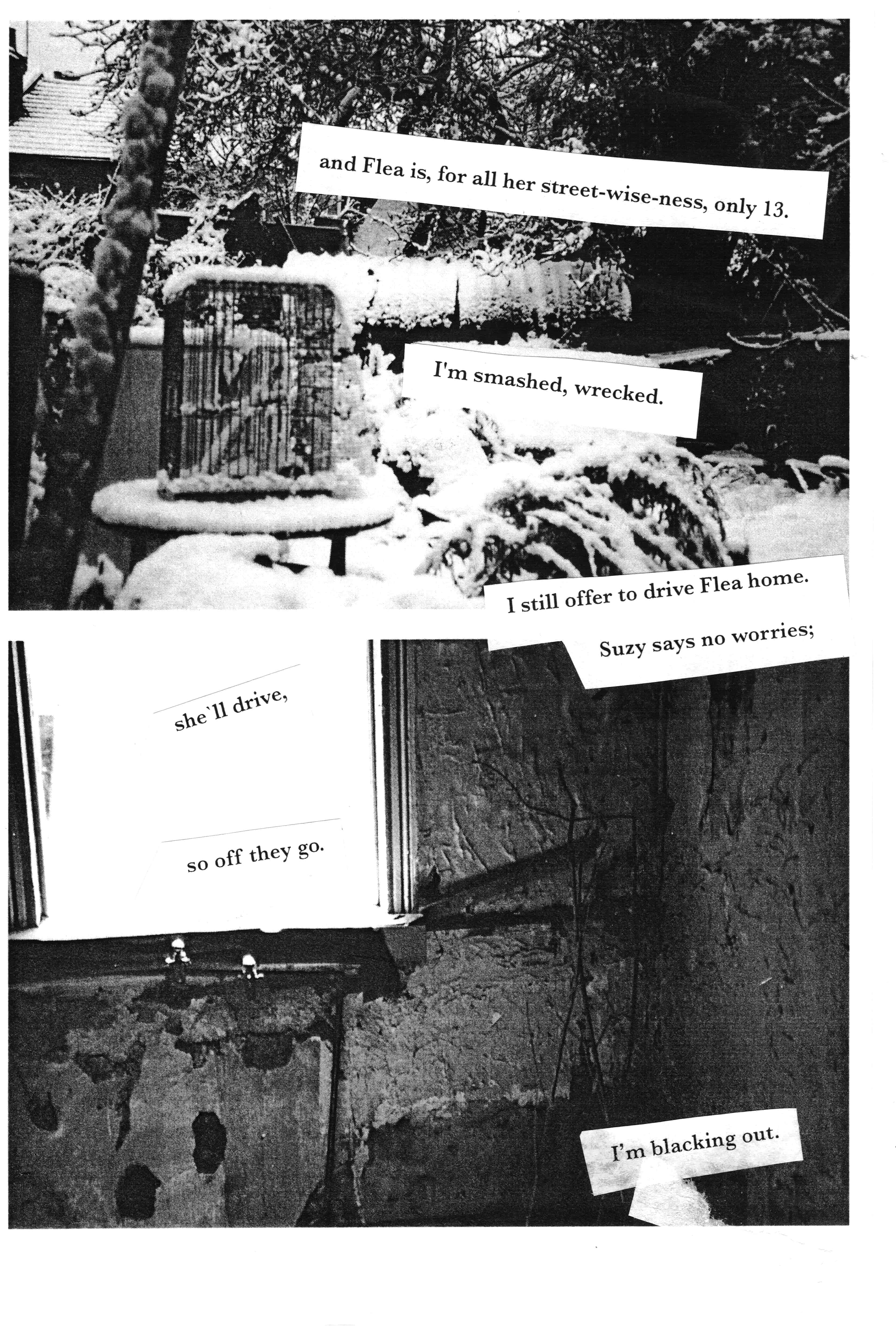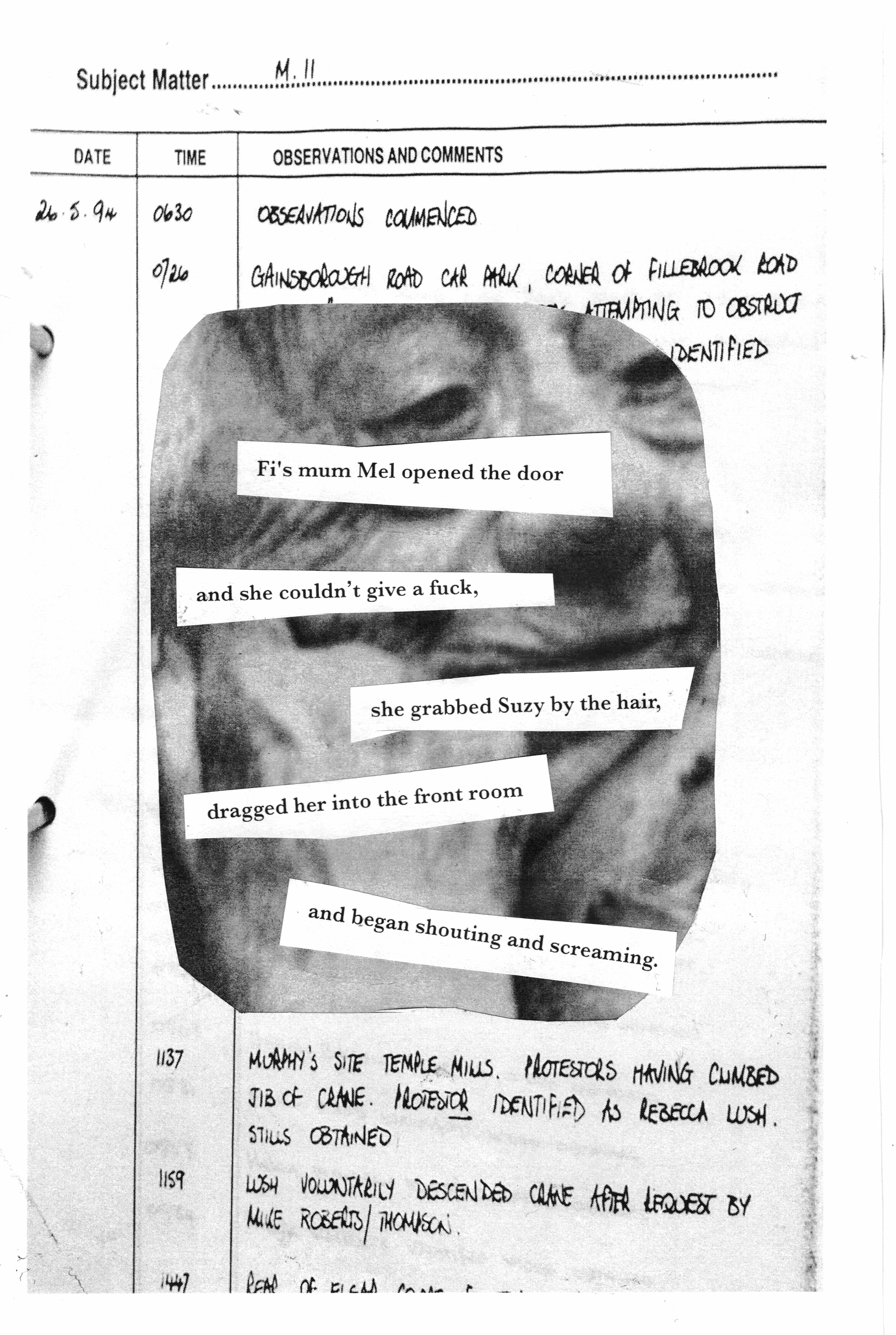Poet Paul Hawkins raises the ghosts of East London’s ‘No M11’ squat protests
- Text by Joshua Gabert-Doyon
- Photography by Excerpt from "Place Space Dissent"

In the early-mid 90’s, when UK rave was getting started and punk was still fresh, a major development project was on the way: the M11 Link Road – connecting East London to the motorway. The roadway would pass through Leytstone, and lead to the demolition of large swaths of neighbourhood. It became the focus of significant protests, with squatters taking up residence in the houses earmarked for demolition.
The conflict came to a head on Claremont Road, where author Paul Hawkins was squatting. Hawkins’ latest book Place Waste Dissent, is a meshing of poetry, investigative journalism, and zine-style collage, featuring photos from the area, the protests, and of the people who lived on Claremont Road. Published by the London-based Influx Press, the book pushes at the boundaries of genre, telling the gritty east London story through the eyes of the residents. Huck spoke to Hawkins about the book and the Leytonstone protests.
How heated did the protests get?
Tempers frayed a lot. There were physical injuries. Friends would recall incidents of Police and security guard brutality, especially towards the end, in the last 6 months. People were up high in trees and on the roof. The authorities got pissed off with the protest – the strength, resilience and energy of the resistance.
But, remember I was squatting there until 1993, and then visited as often as I could . . . The demolition company Squibb and Davies were just as bad. Some of their ‘staff’ were thugs, not only in how they interacted, but in the intimidation, the smashing up of protesters vehicles during the night, the torching of a bender at the George Green site, in which people were sleeping – these are just a few examples.
The integration of official documentation – eviction notices, police reports – is really well done in the book. They offer this sort of counterpoint to the lived experience of Dorothy (who lived on Claremont Road since her birth in 1901, and became an ally of the protesters). Can you talk a bit about your approach to balancing the different narratives?
Thanks. I wanted to produce something lived, as you noted, something concrete too, and the use of form in poetry is really important to me. I like to create text that moves away from more traditional forms, like sonnets, haiku, quatrains or tercets. Not that there’s anything wrong with these forms, it’s just that they feel so dated sometimes; so very academic, and the subject matter, the emotional drive behind the writing was something that was of the 21st century, here and now, of immediacy, as well as contradiction and confusion. Hence some poems in the form of official documentation.
What was the research process like for this book – can you describe the experience of revisiting these stories?
It was emotional. Tiring. Shocking. I gathered many cuttings, photos, articles, etc. whilst squatting in Claremont, and continued to do so over the ensuing years. Some of these prompted a pamphlet collection of poems called Claremont Road in 2013. When Gary and Kit at Influx Press gave me the go-ahead for the book, I realised I needed a lot more than memory to rely on. I went to The Museum of London where there’s a big archive of ‘No M11 Link Road’ protest stuff and dipped into that all day.
Watching the documentaries Blight by ‘No M11 Link Road’ protestors John Smith/Jocelyn Pook, and Housewatch by Claremont Road resident Ian Bourn was really helpful as a prompt for getting ideas down. Like a lot of others, I played in bands when squatting there, and just listening back to rehearsal tapes and a live CD we made at one of many benefit gigs was really helpful too.
I went for a walk with my partner Sarer Scotthorne and Gary Budden (editor and 50% of Influx Press) along the whole of the route filming, taking photos and talking about what I remember happening, almost non-stop along what was eventually built: the A12 extension.
The research process was long, and, at times, exhausting – a lot happened along the route, not all of it very pretty. I touched base with Alice Nutter, who had undertaken extensive research of the protest with a view to writing a play about those times, which may still see the light of day, and she reminded me of some challenging times that I’d forgotten about. Shit happens.
The blending of forms – poetry, and collage zine-making stuff – can you talk a little bit about the decisions you were making with that?
I was hugely influenced by the cut-up process; from Tzara, to Gysin/Burroughs and the late David Bowie. Their text experiments were powerful. I also really liked a book by Laura Oldfield-Ford called Savage Messiah, Anmiel Alcaly’s Neither Wit Nor Gold, and fanzines in general.
They all used an approach of scuzzy xeroxed black and white images, cut and stark, pasted typewriter text, drawings and signs. I love the immediacy and roughness of these styles, and so wanted to have a go myself.
I was really helped though by the use of images by Julia Guest, Maureen Measure, Steve Ryan and Sarer Scotthorne in the book. Those photos were simply stunning, and really made the book. I wanted to include everything.
Can you describe the intersections between the environmentalist movement and the squatting that was going on? Place Waste Dissent takes an interesting turn towards rocks and earth at one point near the end of the book…
There were big connections made between environmentalism and implications of mass road-building. The choking planet; Homes Not Roads. Thatcher’s 1989 Roads For Prosperity White Paper (2,700 miles of new or improved road to the trunk road network and 150 new bypasses) was very short-sighted, served the interests of big business and industry, and ultimately very foolish to announce.
The protest movement grew; Twyford Down, The M11, Solsbury Hill and many more, grew out of a sincere fear of the pollution and waste, as well as a growing hatred of the Thatcher/Major axis; things like The Poll Tax, inequality, the housing crisis, and the Criminal Justice Bill. People realised so much was at stake, and that gave a renewed energy to protest together. The original Roads For Prosperity plans were eventually dropped. These problems still continue today, however.
If you try and fix the flawed, corrupt, wasteful, undemocratic, broken project called capitalism, things will never ever improve.
Paul Hawkins’ Place Waste Dissent, is published by Influx Press.
Enjoyed this article? Like Huck on Facebook or follow us on Twitter.
Latest on Huck

Analogue Appreciation: lullahush
Ithaca — In an ever more digital, online world, we ask our favourite artists about their most cherished pieces of physical culture. Today, it’s Irish retro-futurist lullahush.
Written by: lullahush

Spyros Rennt captures connection and tenderness among Berlin’s queer youth
Intertwined — In the Greek photographer’s fourth photobook, he lays out spreads of togetherness among his friends and the German capital’s LGBTQ+ party scene.
Written by: Isaac Muk

The rebellious roots of Cornwall’s surfing scene
100 years of waveriding — Despite past attempts to ban the sport from beaches, surfers have remained as integral, conservationist presences in England’s southwestern tip. A new exhibition in Falmouth traces its long history in the area.
Written by: Ella Glossop

Plestia Alaqad: “Journalists should focus on humanising people”
Huck’s April interview — Having become one of the most crucial and followed voices from inside Gaza in the aftermath of October 7, the award-winning author and journalist is releasing a new memoir, ‘The Eyes of Gaza’, collating diary entries made over the past 18 months. We caught up with her to hear more about it.
Written by: Isaac Muk

The instrument makers taking DIY music to a whole new level
What does it take to construct a modular synth? How do you turn a block of wood into a double bass? Here, four craftspeople explain why they chose to rip up the rulebooks and build their own music-making machines.
Written by: Daniel Dylan Wray

Southbank Centre reveals new series dedicated to East and Southeast Asian arts
ESEA Encounters — Taking place between 17-20 July, there will be a live concert from YMO’s Haruomi Hosono, as well as discussions around Asian literature, stage productions, and a pop-up Japanese Yokimono summer market.
Written by: Zahra Onsori
